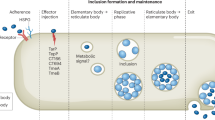Abstract
Chlamydia trachomatis is an important human pathogen with over 130 million new infections per year, world-wide. This obligate intracellular bacterium grows inside a membrane-bound compartment - the inclusion. Recently, using a global approach we were able to comprehensively describe the interactions of the bacterium with cellular proteins. These data indicate the inclusion is an intracellular trafficking hub embedded into the cellular vesicular trafficking pathways.
Similar content being viewed by others
Literatur
Newman L, Rowley J, Vander Hoorn S et al. (2015) Global estimates of the prevalence and incidence of four curable sexually transmitted infections in 2012 based on systematic review and global reporting. PLoS One 10:e0143304
Malhotra M, Sood S, Mukherjee A et al. (2013) Genital Chlamydia trachomatis: an update. Indian J Med Res 138:303–316
Batteiger BE, Tu W, Ofner S et al. (2010) Repeated Chlamydia trachomatis genital infections in adolescent women. J Infect Dis 201:42–51
Moulder JW (1991) Interaction of chlamydiae and host cells in vitro. Microbiol Rev 55:143–190
Mehlitz A, Rudel T (2013) Modulation of host signaling and cellular responses by Chlamydia. Cell Commun Signal 11:90
Elwell C, Mirrashidi K, Engel J (2016) Chlamydia cell biology and pathogenesis. Nat Rev Microbiol 14:385–400
Sinai AP, Joiner KA (1997) Safe haven: the cell biology of nonfusogenic pathogen vacuoles. Annu Rev Microbiol 51:415–462
Rzomp KA, Scholtes LD, Briggs BJ et al. (2003) Rab GTPases are recruited to chlamydial inclusions in both a species- dependent and species-independent manner. Infect Immun 71:5855–5870
Herweg JA, Hansmeier N, Otto A et al. (2015) Purification and proteomics of pathogen-modified vacuoles and membranes. Front Cell Infect Microbiol 5:48
Aeberhard L, Banhart S, Fischer M et al. (2015) The proteome of the isolated Chlamydia trachomatis containing vacuole reveals a complex trafficking platform enriched for retromer components. PLoS Pathog 11:e1004883
Haft CR, de la Luz Sierra M, Bafford R et al. (2000) Human orthologs of yeast vacuolar protein sorting proteins Vps26, 29, and 35: assembly into multimeric complexes. Mol Biol Cell 11:4105–4116
Author information
Authors and Affiliations
Corresponding author
Additional information
Sebastian Banhart 2000–2007 Biologiestudium an den Universitäten Stuttgart und Hamburg. 2011 Dissertation am Max-Planck-Institut für Infektionsbiologie, Berlin (Prof. Dr. T. F. Meyer). Seit 2011 wissenschaftlicher Mitarbeiter am Robert Koch-Institut, Berlin.
Dagmar Heuer 1994–1999 Humanbiologiestudium an der Universität Marburg. 2004 Dissertation am Max-Planck-Institut für Infektionsbiologie, Berlin und an der Universität Marburg (Prof. Dr. T. F. Meyer und Prof. Dr. H.-D. Klenk). 2004–2011 wissenschaftliche Mitarbeiterin und Teamleiterin am Max-Planck-Institut für Infektionsbiologie, Berlin. 2011–2017 Nachwuchsgruppen- und seit 2017 Fachgebietsleiterin am Robert Koch-Institut, Berlin.
Rights and permissions
About this article
Cite this article
Banhart, S., Heuer, D. Intrazellulär gut vernetzt - das Proteom der chlamydialen Inklusion. Biospektrum 23, 756–758 (2017). https://doi.org/10.1007/s12268-017-0866-5
Published:
Issue Date:
DOI: https://doi.org/10.1007/s12268-017-0866-5




